

 Vol. 39 (# 10) Year 2018. Page 7
Vol. 39 (# 10) Year 2018. Page 7
Amador DURÁN-SÁNCHEZ 1; José ÁLVAREZ-GARCÍA 2; María de la Cruz DEL RÍO-RAMA 3; Paúl Oswaldo SARANGO-LALANGUI 4
Received: 22/10/2017 • Approved: 20/11/2017
ABSTRACT: During the last decades, Information and Communication Technologies (ICT) have revolutionized all aspects of society, from production and distribution systems of large companies to interpersonal relationships, a fact to which education is no exception. Developing new technologies allows students to learn more effectively, efficiently, flexibly and comfortably. They use smart devices to access digital resources through the wireless network and immerse themselves in trouble-free personalized learning. In recent years, smart education within the Smart City, as a concept that describes learning in the digital age has gained more attention, allowing for the development of context-sensitive, ubiquitous learning environments (u-learning), capable of implementing adaptations and providing the right support at the right place and at the right time based on the students´ individual needs. Thus, the main purpose of our article is to show the current state of scientific production on Smart Learning through a comparative bibliometric study of the indexed documents in WoS and Scopus databases, dealing with aspects such as the correlation between growth, overlap, dispersion and concentration of articles. To do this, and through an advanced search for terms, we selected a representative set of 149 papers in Scopus and 107 in WoS until 2016 that form the ad-hoc base of the analysis. In view of the results, the conclusion is that although WoS and Scopus databases differ in terms of scope, data volume and coverage policies, the documents and the results of their analysis are in many aspects similar, with Scopus having greater coverage in the specific area of Smart Learning by collecting more articles, papers, journals and signatures. |
RESUMEN: Durante las últimas décadas las Tecnologías de la Información y de la Comunicación (TIC) han revolucionado todos los aspectos de la sociedad, desde los sistemas productivos y de distribución de las grandes empresas, a las relaciones interpersonales, hecho al cual la educación no ha permanecido ajena. El desarrollo de nuevas tecnologías permite a los estudiantes aprender de manera más eficaz, eficiente, flexible y cómoda. Utilizan dispositivos inteligentes para acceder a los recursos digitales a través de la red inalámbrica y sumergirse en un aprendizaje personalizado y sin problemas. En los últimos años, la educación inteligente dentro de la Smart City, como concepto que describe el aprendizaje en la era digital, ha ganado una mayor atención, permitiendo el desarrollo de entornos de aprendizaje ubíquos (u-learning) sensibles al contexto, capaces de implementar adaptaciones y proporcionar el apoyo adecuado en el lugar preciso y en el momento exacto sobre la base de las necesidades individuales de los estudiantes. De este modo, el propósito principal de nuestro artículo ha sido mostrar el estado actual de la producción científica sobre Smart Learning mediante un estudio bibliométrico comparativo de los documentos indexados en las bases de datos WoS y Scopus tratando aspectos tales como la correlación entre crecimientos, cobertura, solapamiento, dispersión y concentración de artículos. Para ello, y mediante una búsqueda avanzada por términos, se seleccionaron un conjunto representativo de 149 trabajos en Scopus y 107 en WoS hasta 2016 que conforman la base ad-hoc del análisis. A la vista de los resultados se concluye que, si bien las bases de datos WoS y Scopus difieren en términos de alcance, volumen de datos y políticas de cobertura, los documentos y los resultados de su análisis son en muchos aspectos semejantes, siendo Scopus quién mayor cobertura realiza en el área concreta del Smart Learnig al recoger un mayor número de artículos, comunicaciones, revistas y firmas. |
The new society model that new technologies are slowly outlining, together with the internationalization of the economy, communication and information globalization and diversified employment, make changes in education systems inevitable and necessary. Being the education system immersed in a society in constant transformation, it is unthinkable for the educational institution to remain unaware of the modifications that are constantly taking place (Marchesi & Martín, 1998).
Technological progress is achieved at an exponential growth rate and with a global reach, which gives rise to adaptive responses by individuals and institutions depending on the innovation-acceptance-consolidation-obsolescence flows of the technology being developed. As a direct consequence of this, technology modifies processes, simplifies and automates different levels of workflow and causes changes in people's competences, where the teaching and/or learning processes are obviously not oblivious to this circumstance. The emergence of Information and Communication Technologies (ICT) as an educational tool is a conceptual and methodological turning point in the way educational and non-educational institutions face educational processes and manage learning.
The smart concept is used in everyday language to refer to an action or decision that involves careful planning, intelligence, innovation and/or a desirable outcome (Spector, Ifenthaker, Johnson, Savenye & Wang, 2015). Applying this concept to the learning environment is a new paradigm in global education. The objective of intelligent education is to improve the learning quality throughout the student's educational process. It focuses on contextual, personalized and transparent learning capable of encouraging the emergence of students' intelligence and facilitating their ability to solve problems in real environments. Thus, intelligent learning does not only involve formal or traditional learning (learning within the school curriculum), but also informal learning, which involves all other forms of learning through informal channels (social media, the Internet, MOOCs, game-based learning, etc.).
Intelligent learning as an element of education plays an important role in the sustainable development of Smart Cities. The overall objective of intelligent education under the smart city architecture is to provide each citizen with personalized services and a complete learning experience. Creating a smart learning environment in the smart city is one of the key elements for innovative and sustainable development. Students are provided with personalized education with the creation of so-called smart learning environments, where they can learn flexibly, in any place and at any time, and work collaboratively, thus promoting both personal and collective intelligence.
In recent years intelligent education has gained importance by carrying out a large number of studies and educational projects focused on intelligent learning. Due to the interest it arouses within the academic world, the main objective of this study is to perform an analysis of the scientific literature published related to Smart Learning through a bibliometric-comparative study of the articles indexed in WoS and Scopus, in order to determine which of the two bases performs greater coverage, as well as the overlap between them. In the same way, and as secondary objectives, through statistical methods and bibliometric indicators, the object is to detect how much, who, what, where and how research on Smart Learning has been done.
In order to locate documents focused on Smart Learning, and indexed in both WoS and Scopus, an advanced search for terms with a time limit in 2016 was performed within both bases. As a result, a set of 85 conference papers and 22 articles in WoS, 90 and 59 respectively in Scopus were selected, which constitute the ad hoc empirical base of the study, processed later through the bibliographic manager Refworks.
This article is divided into four sections. First, and after this introduction, we proceed to the review of the academic literature in order to establish the theoretical framework. Next, section 3 describes the methodology of calculations and the tracking strategy used for the selection of references. In section 4, we detail the main results obtained in the study of the basic bibliometric indicators, as well as the overlap and singularity analysis between the bases. Finally, section 5 presents the final conclusions reached and the limitations associated with the research.
As an educational paradigm, intelligent learning bases its foundations on new technologies and smart devices that help students learn by providing flexibility in the learning mode (Lee, Zo & Lee, 2014; Kim, Song & Yoon, 2011). This new form of education is called technology-enhanced learning (or TEL).
With the development of mobile technologies, learning through mobile devices has become an important TEL tool focused on student mobility and ubiquitous learning, in contrast to traditional types of static education, allowing to learn at anytime, anywhere and facilitating solving real problems by students (Hwang, Tsai & Yang, 2008).
Despite several attempts made by researchers, there is no clear and unified definition of intelligent learning. According to Noh, Ju & Jung (2011), intelligent learning is a self-directed, human-center learning method that connects information technology with the educational environment. For Kwak (2010), Smart Learning is adaptive and involves many other types of learning and skills, enabling students to encourage thinking, communication and problem-solving skills through the use of smart devices. Middleton (2015) also focuses his studies on the student and how he benefits from the use of intelligent technologies, allowing students to participate in their learning and increase their independence.
But the approach should not be limited to the use of smart devices. Kim, Cho and Lee (2013) believe that intelligent learning is a student-center, service-oriented educational paradigm rather than only focusing on the use of devices. Lee (2010) stated that intelligent learning is realistic, attractive, informal and creative. It increases the sense of reality and commitment, it decreases the limit between playing and learning, and it improves cognitive and creative abilities.
In short, intelligent learning is a humanistic approach to learning that provides practical and personalized opportunities to acquire information, manage knowledge, interact and collaborate with peers and instructors, so that students can apply their knowledge and skills to solve problems and achieve goals (Sung, 2015).
On the other hand, many authors aim to establish common characteristics present in the definition of Smart Learning. Thus, Lee (2010) states that intelligent learning is realistic, attractive, informal and creative, enhances the sense of reality and commitment, decreases the limit between playing and learning, and improves cognitive and creative abilities. The characteristics of intelligent learning are motivational, self-directed, in real-time and personalized (Kim, 2010).
The Ministry of Education, Science and Technology of the Republic of Korea (2011) establishes 5 main peculiarities: self-directed, motivated, adaptive, resource enriched and technology embedded. These characteristics imply that intelligent learning expands educational time, methods, competencies, content and spaces (Figure 1). It is self-directed as it expands education time and enables just-in-time learning, motivated by expanding educational methods by providing experimental and collaborative activities. In addition, the adaptive feature improves educational skills by providing personalized and individualized learning, while expanding the range of educational resources. Finally, embedded technology broadens the education space by providing local and global communication networks.
Figure 1
Basic characteristics of intelligent learning. Source: Ministry of Education, Science
and Technology of the Republic of Korea (MEST) (2011), extracted from Sung (2015).
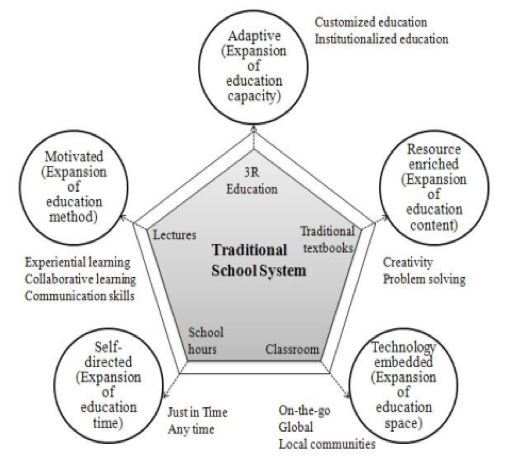
Some of these elements are highlighted by other authors. Thus, for Knowles, Holton and Swanson (2005), in self-directed learning the student is in a dominant position of his education, gives importance to previous experience, facilitates problem-focused learning and motivation increases the learning effect. Therefore, it is considered a much more personalized learning.
Other researchers add other features to Smart Learning: interaction (Wagner & McCombs, 1995) defined as active knowledge and the exchange of opinions between the student-instructor, learner-student and those other individuals or groups that are related to learning; or LMS (Learning Management Systems) (Kim, Jang, Kim & Choi, 2009) seen in (Kwon et al., 2013), an information management system that manages learning attendance, registration, learning resources and measurement of learning outcomes. In this study, LMS is defined as an efficient management system of educational learning that includes the exchange and interaction of educational contents of intelligent learning.
Another important concept to know when establishing a theoretical framework for Smart Learning is the concept of Smart Learning Environments. In general, the smart learning environment must be effective, efficient, appealing and motivating (Merrill, 2013), with the student always at the heart of the learning environment with the objective of providing him with self-learning services adapted to his own personal characteristics (Kim et al., 2013). Koper (2014) proposed that smart learning environments are defined as physical environments enriched with adapted technology and devices capable of promoting better and faster learning. The smart learning environment not only enables students to access a wide range of resources and interact with learning systems anytime, anywhere, but also provides guidance and tools for more effective learning.
By reviewing the literature, we can find that smart learning environments are focused on the student´s efficient and effective learning, with a personalized and adaptable service, interactive and collaborative tools and with access at any time and from anywhere.
Ha and Kim (2014), by analyzing trends in research on Smart Learning found that it is an area of growth with plenty of work done in higher education, where the benefits are both for teachers and students and related to m-learning (mobile learning). Following Hwang (2014), the fundamental issues of research work in Smart Learning should focus on:
1. Development and implementation of smart learning environments: Rapid progress of digital and analytical technologies enables the implementation of smart learning environments from different pedagogical perspectives and with new educational purposes.
2. Interpretation and examination of existing pedagogical theories for smart learning environments: new modes of learning will raise new pedagogical issues which leads researchers to propose new ideas on existing pedagogical theories, such as constructivism or the motivation theory (Mayer & Moreno, 2003).
3. Learning strategies and assessment for Smart Learning: Existing enhanced technology and learning strategies in technology may need to be reconsidered and reviewed. On the other hand, new learning concepts could provide good opportunities for researchers to develop new strategies to help students gain knowledge more effectively and efficiently and solve real world problems.
4. Innovative applications and training in the new learning model: A goal to achieve is that with new technologies and learning concepts, researchers explore new application domains that are difficult to achieve with existing learning environments, such as arts, design or physical education.
5. Performance evaluation and learning perception: Knowing more about learning outcomes and perceptions is very helpful for researchers to develop more effective smart learning environments.
6. Learning behavior’s and learning pattern analysis: Deep understanding of students' behavior’s and learning patterns in integrated real-world environments for the development of more effective learning tools. In the long-term, the analysis of learning behavior’s could be carried out in such a way that researchers would be able to learn more about the social impacts of new educational technology.
In this section the process followed for developing the comparative and overlap study between the multidisciplinary data bases WoS and Scopus in relation to the scientific production on Smart Learning is collected. Our objective was not to assess the content quality of the selected papers, but a descriptive-quantitative analysis through bibliometric indexes.
Since access to the entire scientific production is an unreachable goal, any bibliometric analysis is limited by the availability, relevance and reliability of the information (Rueda, Gerdsri & Kocaoglu, 2007). Bibliographic databases are the main source of information used in many of the scientific studies and the validity of the results obtained will depend largely on their adequate selection and the coverage of the study area. It is precisely this fact that makes WoS and Scopus the bases of our study, since they both appear frequently as documentation sources in the scientific literature.
Web of Science is a web-based platform created in 1960, owned by Thomson Reuters. It integrates several bibliographic databases and information analysis tools that allow to evaluate and analyze the performance of scientific research. It contains citations and references of publications of all disciplines of knowledge, scientific, technological, humanistic and sociological since 1945: 12,000 in-press journals, 23 million patents, 148,000 conference proceedings, more than 40 million sources and 760 million citied references. By areas, 65% of indexed journals cover the fields of Natural Sciences (including Health Sciences), 23% Social Sciences and 12% Arts and Humanities.
Scopus is the bibliographic, multidisciplinary and international database created by the publishers Elsevier in November 2004 with citation analysis since 1996, and which provides an overview of scientific and research production. It contains more than 53 million references published in more than 21,500 scientific journals (4,200 open access titles). It also includes 360 commercial publications, 530 series of books, 7.2 million papers from more than 88,800 events worldwide, 27 million patents. Of the total of journals, 32% cover the area of Health Sciences, 29% the field of Physical Sciences, 24% of Social Sciences and 15% of Natural Sciences.
There are two main procedures to perform the overlapping calculations; on the one hand, based on the primary sources that cover the secondary sources. On the other hand, using documents (articles and papers in our case) that such sources contain. The problem of the first procedure is that there are different policies for document indexing by each database; while some transfer all sources, others do so selectively (Pao, 1993). The latter requires more effort when comparing databases. In this paper, both procedures are followed to analyse the overlap between WoS and Scopus bases in the Smart Learning area.
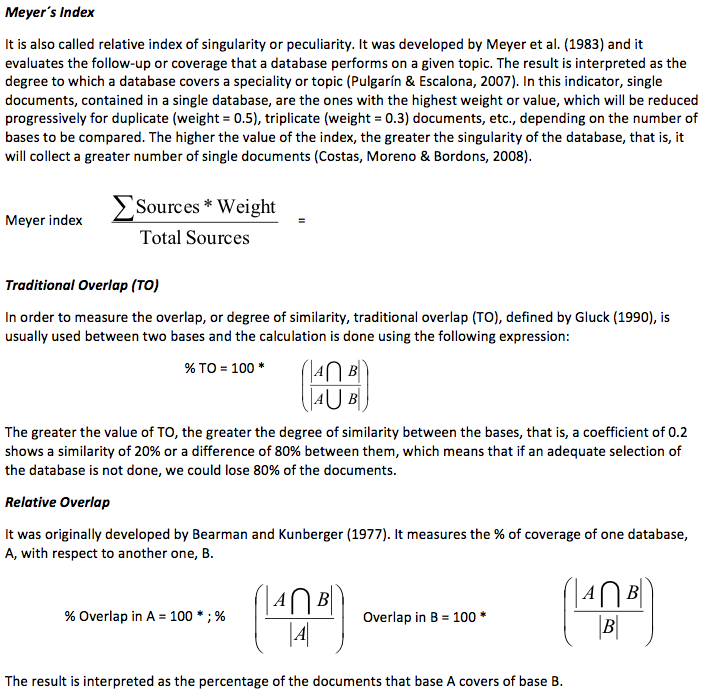
3.3. Tracking methodology
When developing the bibliometric indicators, in addition to analyzing articles published in scientific journals, which is the main means of transmitting the results of an investigation (Maltrás-Barba, 2003), the papers submitted to congresses are studied, given the great importance they have in the work on Smart Learning. Thus, comments, press articles, editorials, notes, letters or errata contained in WoS or Scopus are excluded.
In order to be able to delimit the results of document tracking to the field of Smart Learning, the search equation modality was used. This variety has the advantage of enabling to reach journals classified within all thematic areas of knowledge, resulting the search more comprehensive (Corral & Cànoves, 2013).
After debugging the documents not related to the study area, the ad hoc database to analyze each of the variables needed to obtain the bibliometric indicators was performed.
Figure 2
Growth of Smart Learning documents in WoS and Scopus. Source: Own elaboration.
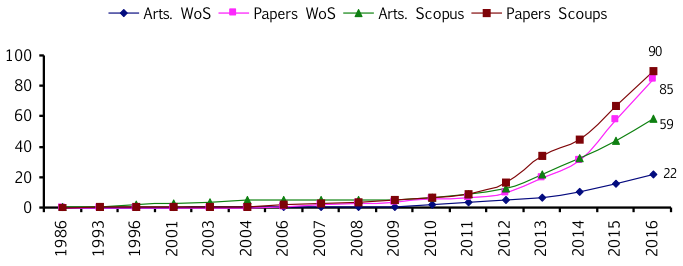
As mentioned, the present paper studies only articles and conference papers collected in the WoS and Scopus databases. Observing the growth of documents related to Smart Learning (Figure 2), it is clear that Scopus indexes a larger number of contributions per year, both articles and papers, with a high degree of correlation between both databases (Figure 3), fit to a correlation coefficient line equal to 0.9199 (R2 = 0.8462).
Figure 3
Correlation between the numbers of paper published in WoS and Scopus. Source: Own elaboration.
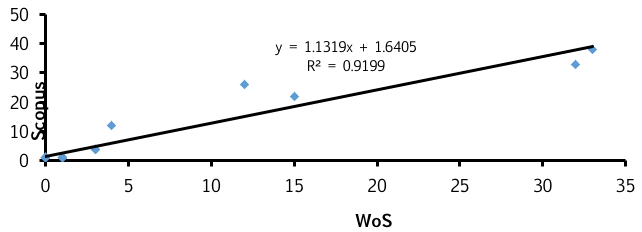
Of the set of selected articles, Smartphones as smart pedagogical tools: Implications for smartphones as u-learning devices (Shin, Shin, Choo & Beom, 2011) stands out by the number of citations received (Table 1), with 64 citations in Scopus and 48 in WoS and also Smart learning services based on smart cloud computing (Kim et al., 2011), with 34 and 19 citations respectively. On the other hand, there are also articles that with a large number of citations that are only present in a single database, for example, teaching a smarter learner (Goldman & Mathias, 1996) in Scopus (55).
Table 1
Documents with 10 citations or more in Scopus o WoS
Title |
Year |
Authors |
Document type |
Quotes Scopus |
Quotes WoS |
Smartphones as smart pedagogical tools: Implications for smartphones as u-learning devices |
2011 |
Shin, D., Shin, Y., Choo, H. & Beom, K. |
Article |
64 |
48 |
Teaching a smarter learner |
1996 |
Goldman, S.A. & Mathias, H.D. |
Article |
55 |
- |
Smart e-learning using recommender system |
2006 |
Soonthornphisaj, N., Rojsattarat, E. & Yim-ngam, S. |
Paper |
35 |
16 |
Smart learning services based on smart cloud computing |
2011 |
Kim, S., Song, S. & Yoon, Y. |
Article |
34 |
19 |
Context-aware services for smart learning spaces |
2010 |
Scott, K. & Benlamri, R. |
Article |
25 |
18 |
Smart e-Learning as a student-centered biotechnical system |
2014 |
Uskov, V., Lyamin, A., Lisitsyna, L. & Sekar, B. |
Paper |
16 |
- |
Smart e-Learning: A greater perspective; From the fourth to the fifth-generation e-learning |
2010 |
Gamalel-Din, S.A. |
Article |
12 |
- |
Increasing adoption of smart learning content for computer science education |
2014 |
Brusilovsky, P., Edwards, S., Kumar, A. et al. |
Paper |
10 |
- |
Three dimensions of smart education |
2015 |
Tikhomirov, V., Dneprovskaya, N. & Yankovskaya, E. |
Paper |
10 |
5 |
A content oriented smart education system based on cloud computing |
2013 |
Jeong, J., Kim, M. & Yoo, K. |
Article |
10 |
-
|
Smart Environments for Smart Learning |
2012 |
Mikulecky, P. |
Paper |
- |
13 |
Smart e-learning using recommender system |
2006 |
Soonthornphisaj, N.; Rojsattarat, E.; Yim ngam, S. |
Article |
- |
16 |
Source: Own elaboration.
As we have seen, we identified 22 articles and 85 papers in WoS, compared to 59 and 90 respectively of Scopus, the number of different articles was 66 in total and the total number of papers 119. Of these, 77.28% and 52.94 % are single documents, collected in only one of the databases, while 22.72% and 47.06% are overlapping or shared by both (Figure 4).
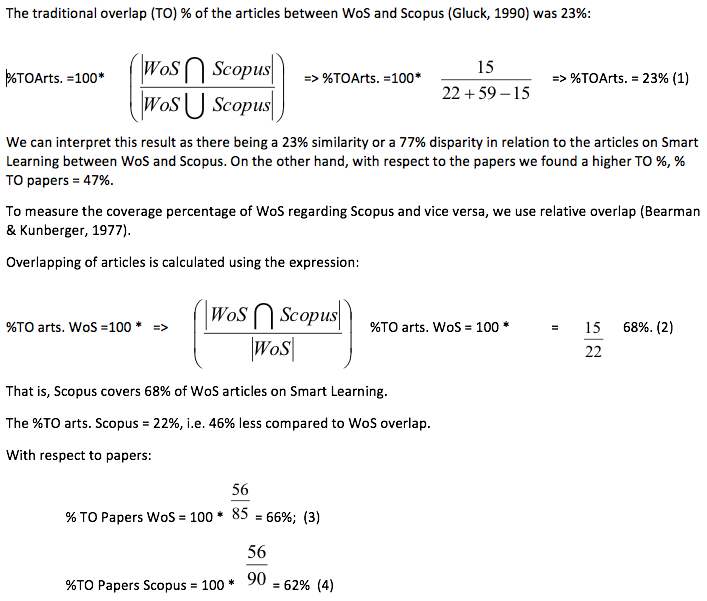
The differences between the overlap of articles can be explained by different indexation policies followed by the databases. Although some journals are included in the two databases, it is possible that not all of their documents are transferred to each of the databases (Costas et al., 2008).
Figure 4
Overlap between WoS and Scopus. Source: Own elaboration

The singularity analysis of the databases was done using the Meyer index (Meyer et al., 1983), which includes the degree of overlap between the bases, and the percentage of single documents present in each of them. The results (Table 2) show a greater singularity of Scopus with 63.77% of articles and 37.78% of single papers, and a Meyer index of 0.75 and 0.69 respectively.
Table 2
Singularity of WoS and Scopus
Databases |
% Single Documents |
Meyer´s Index |
||
Articles |
Papers |
Articles |
Papers |
|
WoS |
31.82% |
34.12% |
0,66 |
0.67 |
Scopus |
63.77% |
37.78% |
0.75 |
0.69 |
Source: Own elaboration.
Using Lotka's law (Table 3), and its calculation of the Productivity Index (PI), we can differentiate between authors with more than 10 published articles (so-called large ones), those with a production between 2 and 9 articles (medium) and authors with a single work (occasional).
Table 3
Lotka. Productivity Index
IP |
Producers class |
n.º articles |
WOS |
SCOPUS |
||
n.º authors |
% authors |
n.º authors |
% authors |
|||
IP>1 |
Large |
n >10 |
0 |
0% |
0 |
0% |
0 < IP < 1 |
Medium |
2 < n < 9 |
32 |
11.55% |
48 |
12.53% |
IP = 0 |
Transient |
n = 1 |
245 |
88.45% |
335 |
87.47% |
Source: Own elaboration.
Table 4 shows that in both databases 88% of the authors are occasional authors with a single article. As a consequence, the average productivity in both bases is low, with a value of 1.16. Yoon, Y.I. with 5 items in Scopus and 2 in WoS, followed by Blimova, M. (4-3), Lee (4-3) and Srivastava (3-3) stand out as the most productive authors.
Table 4
More productive authors
Author |
WoS |
Scopus |
||
Nº. Works |
Lotka |
Nº. Works |
Lotka |
|
Yoon, Y-I. |
2 |
0.3010 |
5 |
0.6990 |
Klimova, B. |
3 |
0.4771 |
4 |
0.6021 |
Ahn, C. |
- |
- |
3 |
0.4771 |
Kim, H. |
- |
- |
3 |
0.4771 |
Kim, S.H. |
- |
- |
3 |
0.4771 |
Kwak, Y. |
- |
- |
3 |
0.4771 |
Lee, Y.J. |
4 |
0.6021 |
3 |
0.4771 |
Pesare, E. |
2 |
0.3010 |
3 |
0.4771 |
Srivastava, A. |
3 |
0.4771 |
3 |
0.4771 |
Mikulecky, P. |
4 |
0.6021 |
1 |
0.0000 |
Lee, H. |
3 |
0.4771 |
2 |
0.3010 |
Lee, J. |
3 |
0.4771 |
2 |
0.3010 |
Park, Y. |
3 |
0.4771 |
1 |
0.0000 |
Tikhomirov, V. |
3 |
0.4771 |
2 |
0.3010 |
Source: Own elaboration.
46.73% of the work on Smart Learning of WoS and 53.02% of Scopus is signed by 2 or 3 authors, and only 24.3% and 20.8% respectively by a single author (Figure 5). Thus, the rate of co-authorship or collaboration (number of signatures per work) was 2.97 for Scopus and 3 for WoS.
Figure 5
Index of collaboration. Source: Own elaboration.
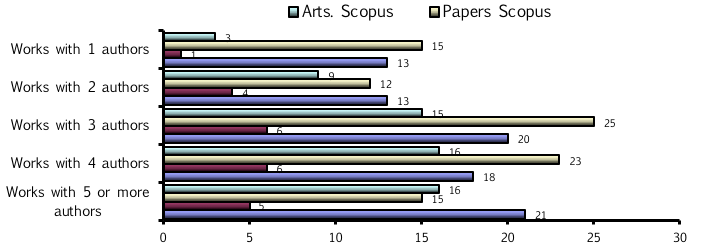
The affiliation data of the authors of articles related to Smart Learning in Table 5 show South Korea and China, followed by India, Canada and the United States, as the main affiliation countries in both databases. South Korea stands out from the rest with 29 articles and 41 different Papers in WoS and 94 articles - 54 Papers in Scopus.
Table 5
Main countries of origin of the authors on Smart Learning
Country |
WoS |
Scopus |
||||||
Articles |
Papers |
∑ |
% |
Articles |
Papers |
∑ |
% |
|
South Korea |
29 |
41 |
70 |
21.81% |
94 |
54 |
148 |
33.41% |
China |
|
30 |
30 |
9.35% |
|
27 |
27 |
6.09% |
India |
|
24 |
24 |
7.48% |
2 |
23 |
25 |
5.64% |
Canada |
3 |
13 |
16 |
4.98% |
5 |
2 |
7 |
1.58% |
United States |
7 |
8 |
15 |
4.67% |
15 |
20 |
35 |
7.90% |
Germany |
2 |
11 |
13 |
4.05% |
3 |
18 |
21 |
4.74% |
Spain |
|
12 |
12 |
3.74% |
3 |
15 |
18 |
4.06% |
United Arab Emirates |
|
11 |
11 |
3.43% |
|
11 |
11 |
2.48% |
Greece |
|
10 |
10 |
3.12% |
|
10 |
10 |
2.26% |
Italy |
|
10 |
10 |
3.12% |
5 |
10 |
15 |
3.39% |
Romania |
|
10 |
10 |
3.12% |
1 |
4 |
5 |
1.13% |
Ukraine |
|
10 |
10 |
3.12% |
|
13 |
13 |
2.93% |
Others |
15 |
75 |
90 |
28.04% |
19 |
89 |
108 |
24.38% |
∑ |
56 |
265 |
321 |
100.00% |
147 |
296 |
443 |
100.00% |
Source: Own elaboration.
The set of 22 WoS articles were published in 19 different journals, of which 16 (84%) collect only a single work. With respect to Scopus, the 59 articles are distributed in 40 journals, 8 of them (20%) collect more than one work.
According to the Bradford´s Law (Bradford, 1934), a small number of journals concentrate most of the published articles on a given topic (Figure 6). This fact allows us to identify Information (Japan), International Journal of Software Engineering and its Applications and International Journal of Applied Engineering Research as the core of publications most used by authors to make their studies known (Table 6).
Figure 6
Lorenz Curve of the WoS and Scopus indexed journals that
include articles on Smart Learning. Source: Own elaboration.

Table 6
Journals with more than 1 article published on Smart Learning
Journal |
Arts. WoS |
Arts. Scopus |
Information (Japan) |
- |
7 |
International Journal of Software Engineering and its Applications |
- |
5 |
International Journal of Applied Engineering Research |
- |
3 |
International Journal of Multimedia and Ubiquitous Engineering |
- |
3 |
International Journal of Smart Home |
- |
3 |
British Journal of Educational Technology |
1 |
2 |
Facta Universitatis-series Electronics and Energetics |
2 |
- |
Indian Journal of Science and Technology |
- |
2 |
International Journal of Engineering Education |
2 |
1 |
Wireless Personal Communications |
2 |
2 |
Others |
15 |
31 |
∑ |
22 |
59 |
Source: Own elaboration.
With respect to the main thematic areas which the studies on Smart Learning can be classified into, we can see in Figure 7 how most of the articles fall into three fundamental areas: Social Sciences with 8 articles in WoS and 18 in Scopus, Computer Science with 5 and 36 articles and Engineering with 6 and 17 articles respectively.
Figure 7
Major areas of research include work on Smart Learning. Source: Own elaboration
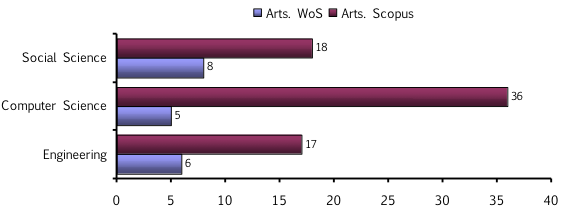
Bibliographic databases play a fundamental role in research by allowing the analysis of scientific activity by researchers, identifying their strengths and weaknesses, and identifying trends. Due to the existence of differences in coverage, information provided and downloading of documents, the selection of the most adequate database in a bibliometric study constitutes an essential phase. Thus, the main objective of this article was to perform a bibliometric analysis of the scientific literature published on Smart Learning comparing the coverage and overlap of two of the main databases in the market, WoS and Scopus, at the same time as responding to how much, where, what, who and how research in this field is done.
From the detailed analysis of the results obtained, we are able to present our main conclusions:
a) Observing the growth of documents related to Smart Learning, it is clear that Scopus indexes a greater number of studies per year, both articles and papers, with a high degree of correlation between both bases.
b) The work collected in Scopus receives a greater number of citations than in WoS. It is worth noting that there are articles that receive a large number of citations and are only present in one of them. In both bases, Smartphones as smart pedagogical tools: Implications for smartphones as u-learning devices (Shin et al., 2011) is the most prominent article due to its number of citations.
c) In spite of the similarities, there are differences in the coverage of both databases, with Scopus being the base that has a greater degree of singularity, that is, it contains a greater number of single articles, covering two thirds of the set of articles and papers of WoS. 19% of WoS's single documents give us the measure of the amount of information that would be lost if Scopus was chosen as the only bibliographic base.
d) Only a small number of authors in both bases are considered as medium with respect to their productivity (with more than one published article). A very high percentage of authors are occasional (one authorship), resulting in a very low average productivity close to 1.16. Yoon, Y-I. is the most productive author with 3 contributions in WoS and 5 in Scopus. On the other hand, a collaboration index closes to 3 shows the authors´ willingness to work jointly.
e) The affiliation data of the authors of articles related to Smart Learning show South Korea and China, followed by India, Canada and the United States, as the main affiliation countries in both databases. As in other areas, universities are the centers to which a greater number of authors are affiliated.
f) Information (Japan), International Journal of Software Engineering and its Applications and International Journal of Applied Engineering Research form the core of publications most used by authors to make their work known.
g) Most of the articles dealing with Smart learning fall into three fundamental thematic areas: Social Sciences, Computer Science and Engineering.
Both databases differ in terms of scope, data volume and coverage policies (López-Illescas, Moya-Anegon & Moed, 2008), although, the documents and the results of their analysis are in many aspects similar. Finally, in the comparison of the coverage of the Smart Learning area, Scopus wins over WoS, by collecting more journals, papers, works and signatures.
The results should be contextualized within the area of Smart Learning taking into account the limitation involved in defining a specific search profile. On the other hand, the aim was not to carry out a quality analysis of the selected documents, an objective that could be raised in a later investigation, but a descriptive-quantitative analysis. In order to expand the research, it would be interesting to extend the comparative study to other databases and perform an analysis of citations and collaboration as those carried out in other areas of knowledge.
Bearman, T.C., & Kunberger, W.A. (1977). A Study of Coverage Overlap among Fourteen Major Science and Technology Abstracting and Indexing Services; National Federation of Abstracting and Indexing Services: Philadelphia, PE, USA.
Bradford, S.C. (1985). Sources of Information on Specific Subjects. Engineering, 10, 85-86.
Corral Marfil, J. A., & Cànoves Valiente, G. (2013). La investigación turística publicada en revistas turísticas y no turísticas: análisis bibliométrico de la producción de las universidades catalanas. Cuadernos de Turismo, 31(1). 55-81.
Costas, R., Moreno, L., & Bordons, M. (2008). Solapamiento y singularidad de MEDLINE, WoS e IME para el análisis de la actividad científica de una región en Ciencias de la Salud. Revista espanola de documentación científica, 31(3), 327-343.
Gluck, M. (1990). A review of journal coverage overlap with an extension to the definition of overlap. Journal of the Association for Information Science and Technology, 41(1), 43-60.
Goldman, S. A., & Mathias, H. D. (1996). Teaching a smarter learner. Journal of Computer and System Sciences, 52(2), 255-267.
Ha, I., & Kim, C. (2014). The research trends and the effectiveness of smart learning. International Journal of Distributed Sensor Networks, 10(5), 537-346.
Hwang, G. J. (2014). Definition, framework and research issues of smart learning environments-a context-aware ubiquitous learning perspective. Smart Learning Environments, 1(1), 4.
Hwang, G. J., Chin-Chung, T., & Yang, S. J. (2008). Criteria, strategies and research issues of context-aware ubiquitous learning. Journal of Educational Technology & Society, 11(2).
Kim, D. J. (2010, November). Smart Platform for Smart Learn ing. In The 2nd Smart Learning Leaders Seminar, Korea e-Learning Industry Association.
Kim, T., Cho, J. Y., & Lee, B. G. (2013). Evolution to smart learning in public education: a case study of Korean public education. In Open and Social Technologies for Networked Learning (pp. 170-178). Springer, Berlin, Heidelberg.
Kim, S., Song, S. M., & Yoon, Y. I. (2011). Smart learning services based on smart cloud computing. Sensors, 11(8), 7835-7850.
Kim, J.S., Jang, H.H., Kim, B.H., & Choi, E.I. (2009). Design of Intelligent U-Learning System for Adaptation of Learning Contents. In Korea Information Processing Society 31th Annual Conference, 16(1), 788-0791.
Knowles, M. S., Holton III, E. F., & Swanson, R. A. (2014). The adult learner: The definitive classic in adult education and human resource development. Routledge.
Koper, R. (2014). Conditions for effective smart learning environments. Smart Learning Environments, 1(1), 5.
Kwak, D. (2010, December). Meaning and prospect for smart learning. In Proceedings from the Seminar for Korea e-learning Industry Association (Vol. 13).
Kwon, H. I., Kim, D. J., Ryu, G. J., Kang, J. H., Park, J. S., & Joo, H. Y. (2013). The Framework of the Smart Learning Infrastructure in South Korea-Focus on Agriculture Education System. In Free and Open Source Software Conference (FOSSC-13) (pp. 18-19).
Lee, S. (2010).Trends and Development of Smart Learning. In Presentation at the 2nd Smart Learning Leaders Seminar, Korea e-learning Industry Association.
Lee, J., Zo, H., & Lee, H. (2014). Smart learning adoption in employees and HRD managers. British Journal of Educational Technology, 45(6), 1082-1096.
López-Illescas, C., de Moya-Anegón, F., & Moed, H. F. (2008). Coverage and citation impact of oncological journals in the Web of Science and Scopus. Journal of Informetrics, 2(4), 304-316.
Maltrás-Barba, B. (2003). Los Indicadores Bibliométricos: Fundamentos y Aplicación al Análisis de la Ciencia; Trea: Asturias, España.
Marchesi Á., & Martín E. (1998). Calidad de la Enseñanza en Tiempos de Cambio; Alianza Editorial S.A, España.
Mayer, R. E., & Moreno, R. (2003). Nine ways to reduce cognitive load in multimedia learning. Educational Psychologist, 38(1), 43-52.
Merrill, M.D. (2013). First Principles of Instruction: Identifying and Designing Effective, Efficient and Engaging Instruction; Wiley: San Francisco, CA, USA.
Meyer, D. E., Mehlman, D. W., Reeves, E. S., Origoni, R. B., Evans, D., & Sellers, D. W. (1983). Comparison study of overlap among 21 scientific databases in searching pesticide information. Online Review, 7(1), 33-43.
Middleton, A. (Ed.). (2015). Smart Learning: Teaching and Learning with Smartphones and Tablets in Post-Compulsory Education. Media-Enhanced Learning Special Interest Group and Sheffield Hallam University Press.
Ministry of Education, Science and Technology of the Republic of Korea (MEST) (2011). Smart education promotion strategy, President’s Council on National ICT Strategies.
Noh, K. S., Ju, S. H., & Jung, J. T. (2011). An exploratory study on concept and realization conditions of smart learning. Journal of Digital Convergence, 9(2), 79-88.
Pao, M. L. (1993). Term and citation retrieval: A field study. Information Processing & Management, 29(1), 95-112.
Pulgarín, A., & Fernández, M. I. E. (2008, February). Medidas del solapamiento en tres bases de datos con información sobre ingeniería. In Anales de Documentación (Vol. 10, pp. 335-344).
Rueda, G., Gerdsri, P., & Kocaoglu, D. F. (2007, August). Bibliometrics and social network analysis of the nanotechnology field. In Management of Engineering and Technology, Portland International Center for (pp. 2905-2911). IEEE.
Shin, D. H., Shin, Y. J., Choo, H., & Beom, K. (2011). Smartphones as smart pedagogical tools: Implications for smartphones as u-learning devices. Computers in Human Behavior, 27(6), 2207-2214.
Spector, J.M., Ifenthaler, D., Johnson, T.E., Savenye, W.C., & Wang, M.M. (eds.) (2015). Encyclopedia of Educational Technology; Sage: Thousand Oaks, CA, USA.
Sung, M. (2015). A study of adults’ perception and needs for smart learning. Procedia-Social and Behavioral Sciences, 191, 115-120.
Wagner, E.D., & McCombs, B. L. (1995). Learner Centered Psychological Principles in Practice: Designs for Distance Education. Educational technology, 35(2), 32-35.
1. Ph. Doctorate Student Research Program in the area of Public Law University of Extremadura (Spain). E-mail: ads_1975@hotmail.com
2. PhD in Direction and Planning of Tourism (University of Vigo). Assistant Professor and Researcher at the Department of Financial Economics and Accounting. University of Extremadura (Cáceres, Spain). Email: pepealvarez@unex.es
3. PhD. in Business Management by the University of Vigo. Assistant Professor and researcher at the Business Organisation and Marketing Department. University of Vigo (Ourense, Spain). Email: delrio@uvigo.es
4. PhD Student in Business at the University of Barcelona (Spain). Research Lecturer in the Department of Business Sciences of the Technical University of Loja (Loja, Ecuador). Email: posarango@utpl.edu.ec